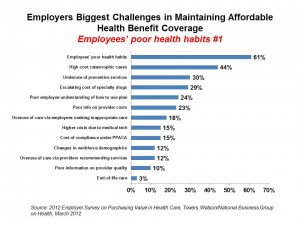 Employers expect total health costs to reach $11,664 per active employee this year, over $700 more than in 2011. Employees’ share of that will be nearly $3,000, the highest contribution by workers in history. In 2012, workers are contributing 34% more to health costs than they did 5 years ago. The metric is that for every $1,000 employers will spend on health care in 2012, workers will pay $344 for premium and out-of-pocket costs.
Employers expect total health costs to reach $11,664 per active employee this year, over $700 more than in 2011. Employees’ share of that will be nearly $3,000, the highest contribution by workers in history. In 2012, workers are contributing 34% more to health costs than they did 5 years ago. The metric is that for every $1,000 employers will spend on health care in 2012, workers will pay $344 for premium and out-of-pocket costs.
Still, health care cost increases are expected to level off to about 6% in 2012, that’s still twice as great as general consumer price inflation. with health costs outpacing the growth of wages for over a decade.
But the long-term view among employers’ confidence that health benefits will be offered by their organization a decade from now has dropped to 23%, from 57% in 2009 and 38% last year.
Welcome to the era of employers value-shopping in health care, according to the 2012 Towers Watson/National Business Group on Health Employer Survey.
As the chart illustrates, employers #1 challenge for maintaining affordable health coverage is changing employee’s poor health habits. Employers ranked this challenge first last year, as well.
To impact health costs, employers’ strategic priorities for 2012 in setting health care strategy for 2013 will include:
- Developing a workplace culture where employees are accountable and supported for health and wellbeing, among 40% of employers
- Staying up to date and complying with the Affordable Care Act (PPACA), for 34% of companies
- Educating employees to be more informed consumers of health care via price transparency, etc., for 33%
- Adopting/expanding the use of financial incentives to encourage healthy behaviors, among 32%
- Developing/expanding healthy lifestyle activities, for 24%
- Reviewing health care benefits as part of a total rewards strategy, for 24%
- Expanding enrollment in account-based health plans, for 21%.
Health Populi’s Hot Points: Employers have cited workers’ poor health habits as the #1 challenge for bending the health cost curve for the second year in a row — so we haven’t licked the wellness challenge yet, either corporately or personally. Companies’ 2013 tactics for addressing health costs largely focus on the personal responsibility of workers: increasing employee engagement, educating employees to be better health care consumers, implementing financial incentives and disincentives, and expanding wellness and lifestyle-enhancing activities. Above all, employers are looking to developing cultures of health in their organizations.
Employee engagement won’t just be a phrase in 2012-2013. Employers will look to their vendors of benefits and services to help them evaluate what works. This is because companies’ greatest disappointment has been the inability for vendors to drive behavior change that results in more efficient use of health resources and, ultimately, healthier lifestyles, Towers Watson and NBGH found in their survey. Changing members’ behavior related to making healthy lifestyle decisions is what employers’ investment in wellness, prevention and health spending is about in 2012.
To motivate employees to make such changes, expanded use of financial incentives and requirements will be a focus for 61% of employers offering wellness programs, with another 21% planning to do so in 2013. 20% will use penalties in 2012, with 22% planning to do so in 2013. And more companies will penalize tobacco use (35% in 2012 and 17% more in 2013), and biometric outcomes (weight control, target cholesterol — 10% in 2012, 23% in 2013). 42% of employers require employees to complete a health risk appraisal (HRA) in 2012, with an additional 26% planning to require HRAs in 2013, to be eligible for financial incentives for healthy activities.
Tower Watson/NBGH also looked at the high performing employers in terms of health costs and employee engagement. 63% of consistent high performers regularly measure gaps in care to make program management decisions, 62% use a website to provide health resources beyond benefit information, 65% offer decision-making support tools, and 47% use personalized reminders of need and timing for preventive services.
Technology also underpins other tactics adopted by high-performing employers for wellness and health:
- 10% offer and incent the use of personal health records, versus 3% of low performers
- 12% offer online games for health vs. 5% of low performers
- 23% use social media tools, discussion forums, and blogs for health, compared to 15% of low performers
- 14% provide online messages to promote primary care use linked to web-based decision support tools, vs. 9% of low performers.
When it comes to health, the highest performing employers are integrating health into a total rewards strategy, building a culture of health within their organizations. They are integrating health risk appraisal data with health care claims data, and pushing their outside benefits vendors to be on this journey with them to promote the overall health of the organization. To do this, the high performing companies are partnering with their employees to more effectively engage in health — and are giving workers the tools and incentives to do so.




 Thanks to Feedspot for naming this blog, Health Populi, as a
Thanks to Feedspot for naming this blog, Health Populi, as a